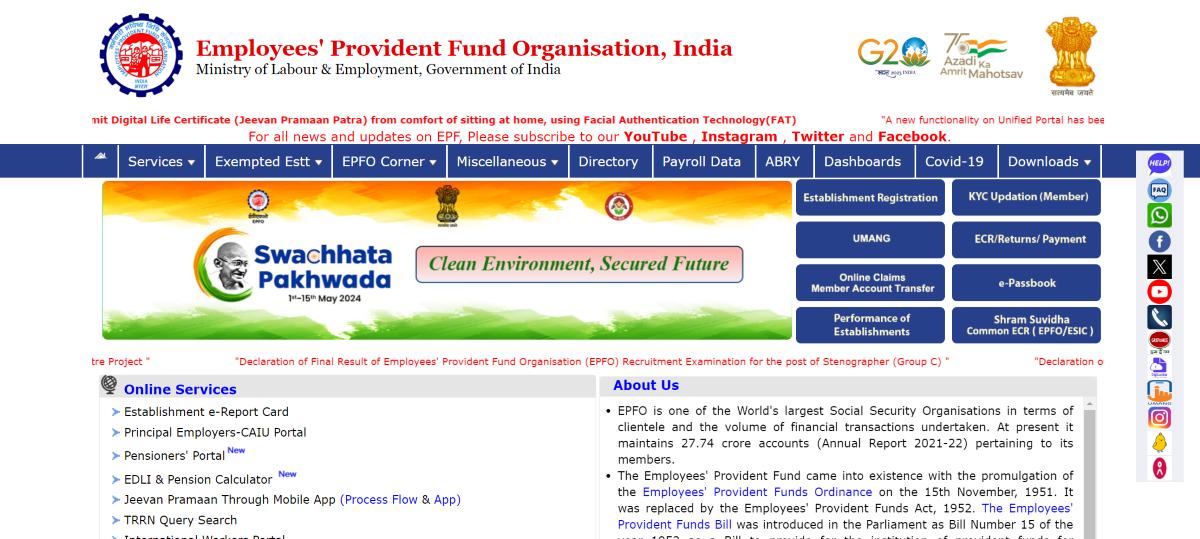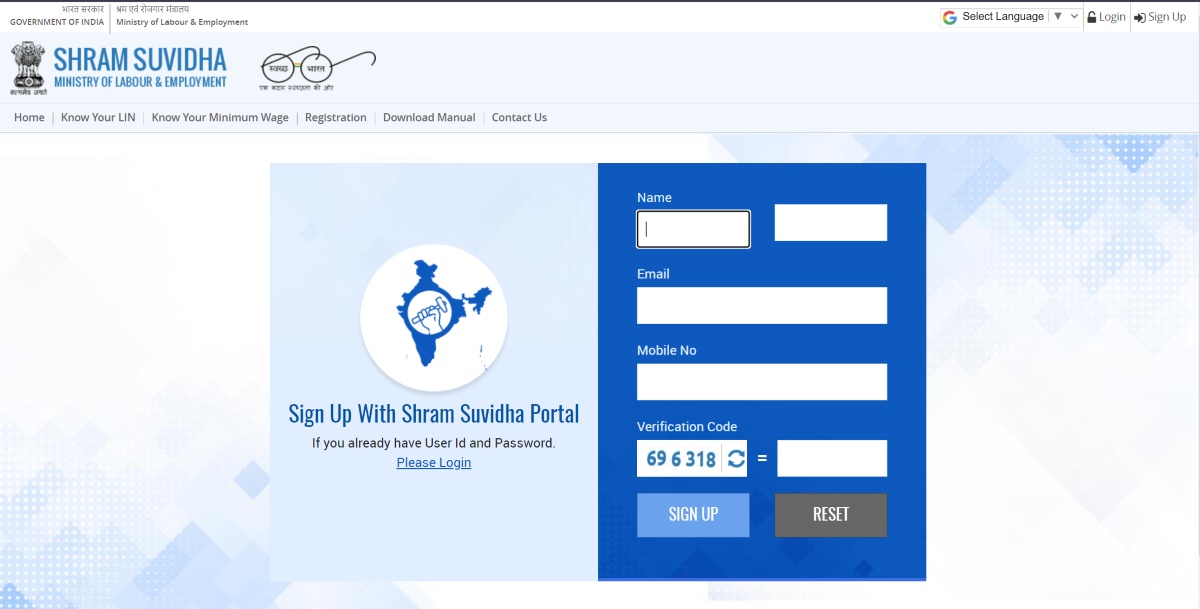EPF Registration Process & How to Open PF Account Online/Offline?

The government started the Employee Provident Fund to secure employees’ future after retirement; it’s a serious arrangement. EPF registration is necessary for companies employing more than a specified number of workers so that employers and employees contribute to a pension corpus.
This article will focus on the significance of registering with EPF, the procedures involved, and its benefits.

Table of Contents

Importance of Employee Provident Fund (EPF) Account
Having an Employee Provident Fund (EPF) account is of paramount importance for several reasons:
Crucial Tool for Retirement: It is crucial for retirement planning to ensure financial security during post-employment. Contributions made throughout one's career accumulate and earn interest, thus providing a substantial corpus upon retirement. Having an EPF Account is useful.
Helps During Financial Distress: An EPF account acts as a safety net during financial distress. During an unforeseen emergency or a sudden loss of employment, people can avail themselves of partial withdrawals or loans from their EPF savings, offering economic stability during challenging times.
Encourages Savings: The EPF scheme encourages disciplined savings habits among employees. Mandating regular contributions from both the employee and the employer fosters a culture of long-term financial planning and instils the habit of saving for future financial requirements.
Tax Benefits: EPF contributions offer tax benefits, with contributions eligible for deduction under the Income Tax Act. This incentivises individuals to contribute towards their EPF accounts, enhancing their overall financial well-being while providing funds for the future.
In essence, the significance of having an EPF account lies in its role as a retirement planning tool, a financial safety net, a promoter of savings discipline, and a provider of tax benefits.
Why is it Necessary to Register an EPF Account?
Registering for an EPF (Employee Provident Fund) account is essential for several reasons:
Employee Benefits: Enrolling in an EPF account ensures that employees get benefits such as savings for retirement and pension schemes and partial withdrawal on certain life events, hence securing their future financial needs.
Administering Ease: Registering with EPF greatly simplifies the management of employee contributions and withdrawals, thereby reducing employers' administrative burdens and ensuring a seamless observance of labour laws.
Financial Stability: Employees who contribute to their EPF account can save regularly, essential for stabilising finances. They accumulate a corpus that can be used for emergencies or long-term financial goals.
Security of Finances: The EPF accounts play an important role in providing economic security by providing a steady source of income after retirement and ensuring cash flow during non-working years for the people and their dependents.
What are the EPF Registration Eligibility Criteria?
The EPF registration is compulsory for establishments meeting the following criteria:
Workforce Strength: A factory in an industry with a workforce strength of 20 or higher.
Notified by Central Government: Other establishments having 20 or more employees or a class of similar establishments specified on this behalf by the central government through a notification.
Low Employee Strength: If the employee strength of a registered organisation falls below the minimum threshold, which is 20 employees, it also remains within the range of the Act's norms.
Mandatory Registration: The Central Government might apply provisions regarding mandatory registration to an organisation with an employee strength of less than 20 after handing over a notice of 2 months.
Voluntary Registration: It would also be necessary for some organisations with fewer than 20 employees to obtain EPF registration, but that comes under voluntary registration.
List of Documents Required for EPF Registration
The documents necessary for EPF registration, which employers should affix to the ‘Registration Form for EPFO’, are listed below:
Bank statement or cancelled cheque of entity
Digital signature of Director, Partner or Proprietor
Leased, hired or rented agreement (if applicable)
PAN card of Partner, Director or Proprietor
Aadhaar card of Director, Partner or Proprietor
GST certificate, shop and establishment certificate, or any license issued for the establishment by the government.
Address proof, such as a registered office's water, electricity, or telephone bill (must not be older than two months).
Steps to Register for EPF Online
If you are an employer willing to register, go through the steps for the EPF registration process given below:
Step 1: Registering Company for EPF
Visit the EPFO web portal to register your company. Select the option stating ‘Establishment Registration’ present on the home page of this unified portal.

Step 2: Download User Manual
When clicking the ‘Establishment Registration’ option, the page will be redirected to the link: https://registration.shramsuvidha.gov.in/user/register. A user manual is available at this link, which you must download. This manual should be read thoroughly before registration if you are new to this process.

Step 3: Register on the Unified Shram Suvidha Portal
After thoroughly reviewing this user manual, sign up on the EPFO Unified Shram Suvidha Portal (USSP). The sign-up page of USSP will open when you click on the ‘Establishment Registration’ tab on the home page. Then, click on the tab marked ‘Sign Up.’
When you click the 'Sign Up' button, you will be asked for your name, mobile number verification code, and email. Input all required details to create an account.
Step 4: Fill Up the Registration Form
Log in to USSP and locate a tab titled ‘Registration For EPFO-ESIC v1.1’ on the screen’s left side. After this, choose the option ‘Apply for New Registration’ on the screen’s right side.
You would find two options on clicking: ‘Employees’ Provident Fund and Miscellaneous Provision Act 1952’ and ‘Employees’ State Insurance Act 1948.’ As an employer, you would have to select the ‘Employees’ Provident Fund and Miscellaneous Provision Act 1952’ option and then click 'Submit.’
When you click the' Submit' button, the page featuring the ‘Registration Form for EPFO’ will be displayed. Here, you need to input employment details, branch or division, contact persons, establishment details, activities, and identifiers.
Step 5: Attaching DSC
After filling out the above registration form and attaching all required documents, the employer’s DSC or Digital Signature Certificate needs to be uploaded and affixed to this form. The Unified Shram Suvidha Platform will email you to confirm that EPF registration has been completed on uploading the DSC.
Steps to Register for EPF Offline
To register for EPF (Employee Provident Fund) offline, you typically need to follow these steps:
Step 1: Collect the Required Forms: Obtain the necessary forms for EPF registration from the nearest EPFO (Employees' Provident Fund Organisation) office or download them from their website.
Step 2: Fill Out the Forms: Fill out the forms with accurate information. This usually includes personal details, employment information, and bank account details.
Step 3: Gather Supporting Documents: Gather supporting documents such as identity proof, address proof, PAN card, and bank account details.
Step 4: Visit the Nearest EPFO Office: Take the filled-out forms and supporting documents to the nearest EPFO office.
Step 5: Submit the Forms: Submit the forms and documents to the EPFO office counter. Make sure to get a receipt or acknowledgement for your submission.
Step 6: Follow-Up: Keep track of your application status by regularly checking with the EPFO office. They may provide updates on the processing of your registration.
Step 7: Activate Your UAN (Universal Account Number): Once your registration is processed, you will receive a Universal Account Number (UAN). You can activate it online through the EPFO portal.
Step 8: Link Aadhaar to UAN: Link your Aadhaar card to your UAN online for easier access to EPF services.
Step 9: Start Contributions: Once your registration is complete, contribute to your EPF account through your employer.
Step 10: Keep Records: Maintain records of your EPF contributions and transactions for future reference.
Benefits of Registering for an EPF Account
Registering for an Employee Provident Fund (EPF) account offers several benefits to employees, such as:
Retirement Savings: Registering for an EPF account is retirement savings that can be built over a working life. In this regard, it serves as a strong retirement saving platform.
Fund Liquidity: This allows individuals to access their funds during pressing times such as health emergencies and economic crises. As such, they create a safety net.
Easy Accessibility: Employees can conveniently keep track of their contributions, verify balances, and administer the account from any location.
Anytime Withdrawal: One can withdraw money from EPF at any time. The individual could use his/her savings when he/she needs it without being tied down by too many regulations.
Partial Withdrawals: EPF accounts permit partial withdrawals for specific purposes such as education, housing, or medical expenses, offering financial support for various life events.
Tax Benefits: This decreases taxable income and incentivises people to save for the future while enjoying tax relief in today’s world.
Applicability for an EPF Account for Employers
For employers, the applicability of an Employee Provident Fund (EPF) account entails several responsibilities, such as:
Builds Employer-Employee Relationship: Establishing EPF accounts for employees demonstrates compliance with statutory regulations, fostering a positive relationship with regulatory authorities.
Long-Term Financial Security: Contributing to EPF accounts on behalf of employees facilitates their long-term financial security, thereby enhancing loyalty and morale within the workforce.
Financial Well-Being: Participation in EPF schemes often enables employers to attract and retain talent, as it signifies a commitment to employee welfare and financial well-being in the long run.
Employer Contributions: Employers play a crucial role in facilitating the seamless operation of EPF accounts, including timely contributions, accurate record-keeping, and compliance with regulatory updates.
What is the Minimum Number of Employees Required to Open an EPF Account for Employers?
In India, the minimum number of employees required to open an EPF (Employees' Provident Fund) account for employers is typically 20 or more employees.
However, certain establishments with fewer than 20 employees can also voluntarily register under the EPF scheme. Depending on the company, the government may send a ‘Mandatory Registration’ letter to the employers.
EPF registration is essential for both employers and employees. It ensures financial security and stability for workers during their retirement years, providing a safety net for their future. By registering for EPF, employers fulfil their legal obligations and contribute to the welfare of their employees. Likewise, employees benefit from long-term savings and retirement benefits through this scheme.













